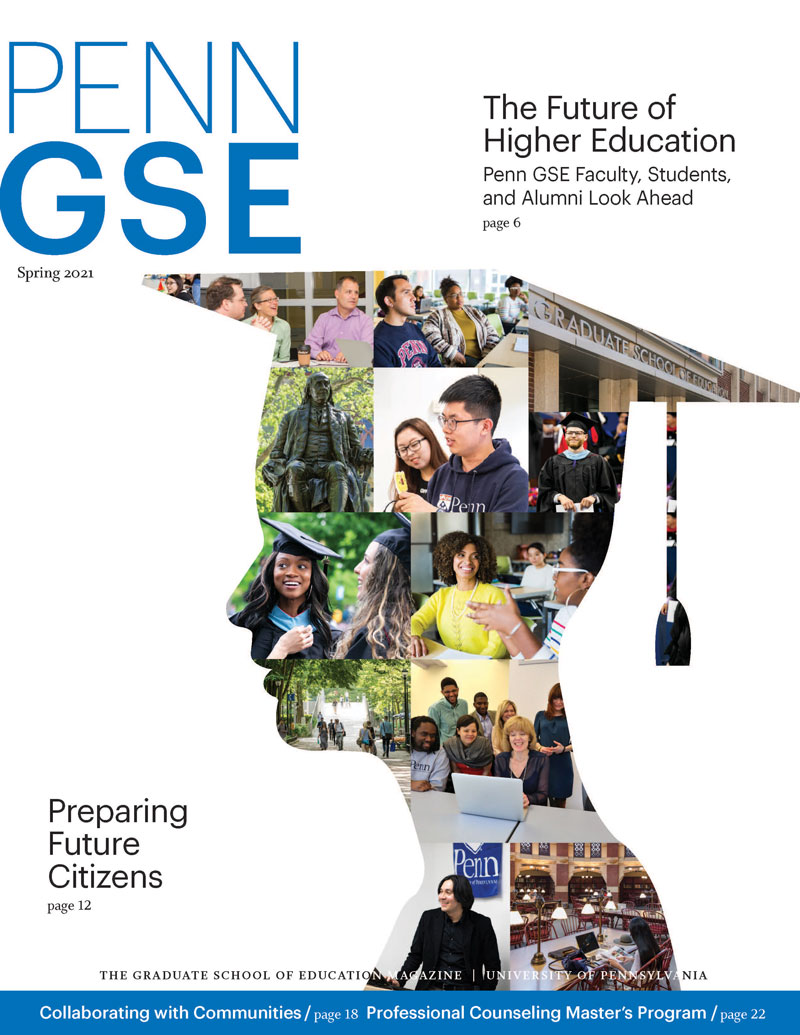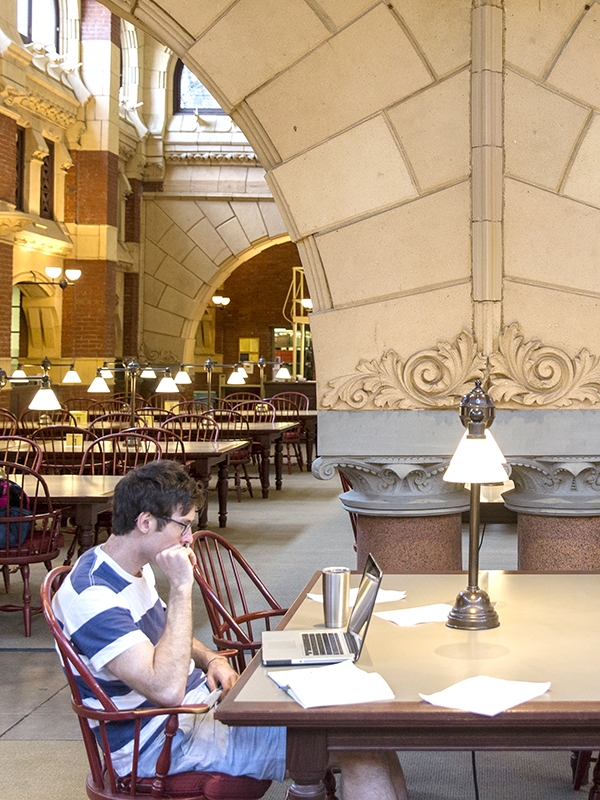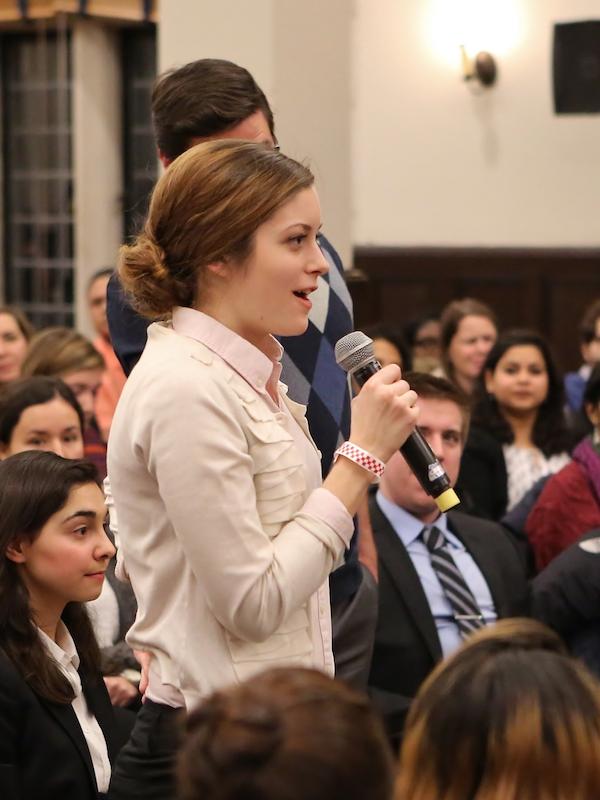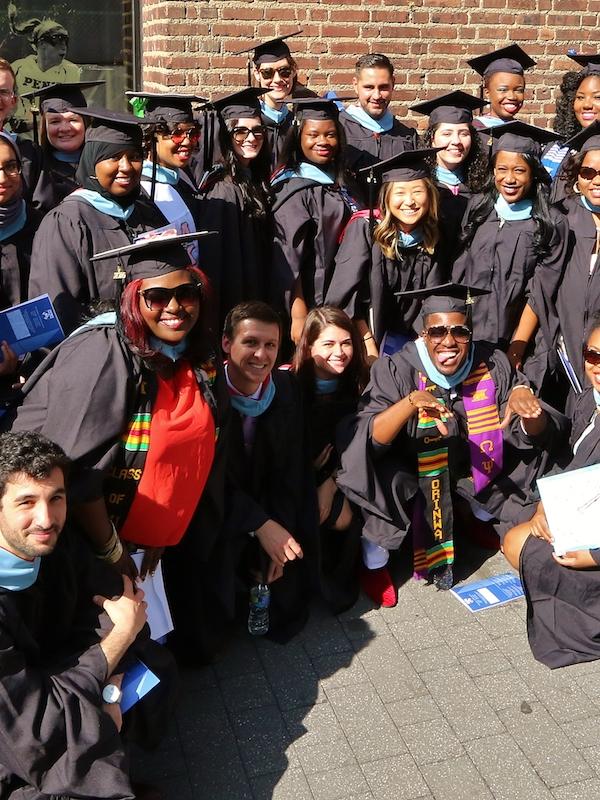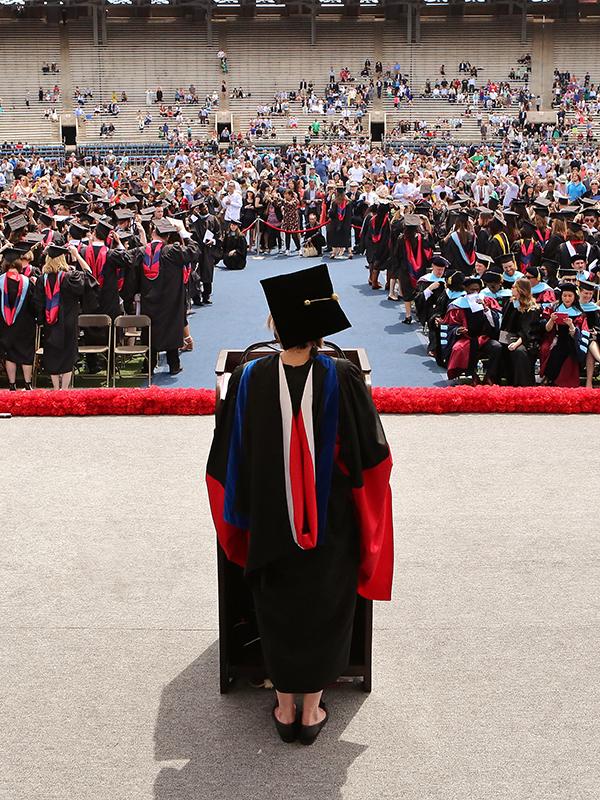The Future of Higher Education: Penn GSE Faculty, Students, and Alumni Look Ahead
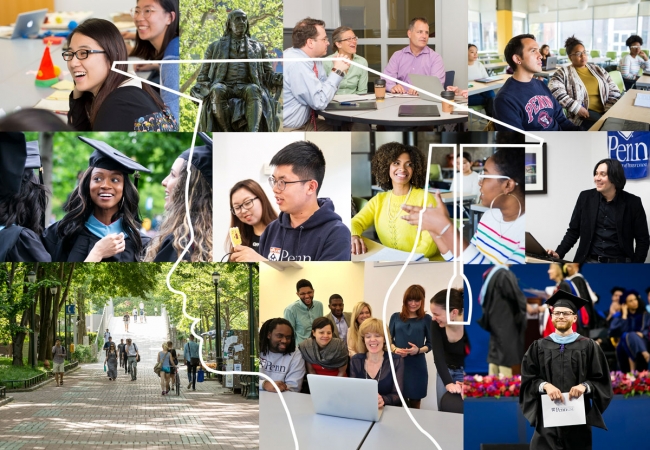
Images by iStock.com/monsitj, Greg Benson Photography, Allison Dougherty, Lora Reehling, Jay Gorodetzer Photography, Krista Patton Photography, and Ryan Collerd.
This story originally appeared in the Spring 2021 print edition of The Penn GSE Magazine.
by Juliana Rosati
Empty campuses, virtual instruction, and financial losses have fueled speculation about the future of higher education since the COVID-19 pandemic began. Now, with the promise of vaccination making it possible to envision a “new normal,” colleges and universities across the nation and around the world continue to navigate vast complexities.
“Within and beyond higher education, the difficulties faced by under-resourced institutions and students have been heightened in dramatic ways,” says Penn GSE Dean Pam Grossman. “Yet I believe that this time can be one we will look back upon as the source of learning, growth, innovation, and real change that advance educational opportunity and racial justice.”
The disruption is daunting, but so were previous challenges faced by higher education, according to Dr. Matthew Hartley, chair of Penn GSE’s Higher Education division, associate dean for academic affairs, and professor.
“Higher education has an interesting way of keeping on and surviving,” he says. Hartley cites a projected drop in demand in the 1990s and the financial crisis in 2008 as challenges that institutions have overcome. The key, he says, may be the people within and beyond institutions who make higher education possible—taxpayers (for public institutions), students, faculty, staff, alumni, and friends.
“Every higher education institution has a community of support. I think it can be easy for people to underestimate the strength of that support,” he says. “Colleges and universities are also filled with people who care deeply about their work and about serving their students, who will stay through tough times.”
Whether researching trends, proposing solutions, or leading institutions, Penn GSE faculty, students, and alumni are studying the state of higher education and preparing to shape its next chapter.
A Challenging Landscape
A significant decrease in U.S. undergraduate enrollment in the fall has continued this spring, with March 2021 data from the National Student Clearinghouse Research Center showing a 5.9 percent drop in undergraduates. As is true of the pandemic across multiple realms, in higher education the crisis has not affected individuals or institutions equally. Penn GSE faculty describe a landscape in which attention to the needs of low-income and minoritized students is more urgent than ever.
“For some institutions, it was harder to get the resources necessary to pivot online effectively, or they couldn’t provide the supports for faculty to do it well, and these circumstances led students to exit,” says Hartley.
In the years prior to the pandemic, some experts had predicted closure for up to half of American colleges. In response, Penn GSE Professor Robert M. Zemsky and co-authors released The College Stress Test, predicting a less dire future in which 10 percent of institutions would face closure and 30 percent would struggle, and providing a research-based tool for colleges to assess their own market viability. Yet the overall dynamic they foresaw was a sobering one.
“Our findings said that strong institutions would get stronger, while weak institutions would be in real trouble,” says Dr. Zemsky. That, he says, proved true when the pandemic hit, just weeks after Johns Hopkins University Press published the book. As the crisis intensified the need for budget cuts, Zemsky and colleagues revised their estimate, predicting closure for 20 percent of institutions—a figure still far shy of half, but representing a substantial portion of the nation’s colleges and universities.
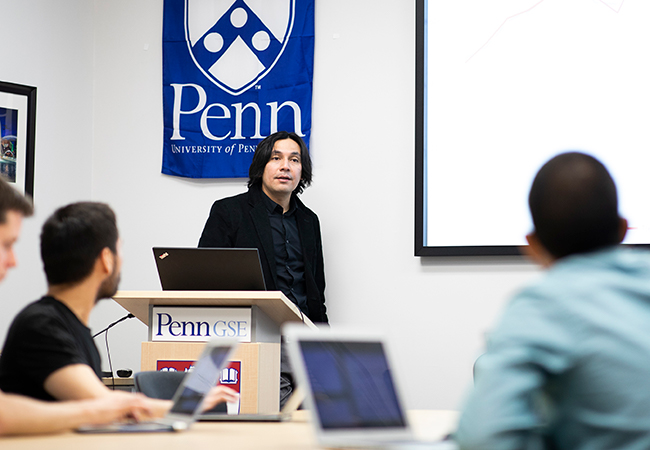
Both in the United States and abroad, falling international enrollment has jeopardized institutions in the wake of travel restrictions. This is particularly the case for universities in Australia, New Zealand, Canada, and the United Kingdom.
“These countries rely on large, publicly supported systems of higher education, where international student income had masked a reduction in state support for forty years,” says Penn GSE Senior Fellow Alan Ruby. “There is an impact in the United States, but it is less dramatic because of the patchwork of different types of institutions and financial models.”
Just as colleges and universities that were already financially fragile have been hardest hit, low-income students have likely faced the greatest obstacles to college due to unemployment, costs, and technological access.
“Some of the data that have emerged so far raise troubling ques- tions about the impact of the pandemic on college enrollment for low-income students and how they’re paying,” says Penn Vice Provost for Faculty Laura Perna, GSE Centennial Presidential Professor of Education. Dr. Perna, whose research addresses how cost and other factors put college within or beyond reach for students, points to lower completion rates of the FAFSA, the form that is necessary to receive federal financial aid, among high school seniors.
The national drop in enrollment has been steepest at community colleges, a troubling sign given their reputation for serving a high percentage of students of color and representing an affordable option for low-income students. According to Penn GSE Associate Professor Manuel S. González Canché, financial challenges may have limited community colleges’ ability to pivot online as effectively as for-profit institutions with significant online programs. In addition, he says, their students may have lacked access to computers and broadband internet or may have needed to prioritize other responsibilities.
“Students who can afford to stay enrolled and be online have likely continued; those who are making an extra effort because they are parents and they have to work may have chosen to pause their studies,” says Dr. González Canché, who views community colleges as an important point of access to higher education for minoritized and at-risk students.
At four-year institutions, standardized tests are one step to admission that was widely removed during the pandemic, but this change will not automatically improve college access. “Test-optional policies increase the application pool, but that does not mean underrepresented students will be admitted at a higher rate,” says González Canché, who has studied the impact of such policies in the past.
“Students who can afford to stay enrolled and be online have likely continued; those who are making an extra effort because they are parents and they have to work may have chosen to pause their studies.” — Dr. Manuel González Canché
In addition, he and Perna share the concern that the disruption of K–12 education threatens future college students’ academic readiness. “The most-resourced K–12 schools have done the best in figuring out how to support their students during COVID. And the schools that were struggling before have continued to struggle to provide high-quality college preparation,” says Perna.
A Time to Reflect on Value and Strategy
In the midst of these challenges, questions about the value of a college degree have gained traction. “There is an existential question in higher education about the return on investment,” says Penn GSE Senior Fellow Michael Golden, GRD’07, executive director of Catalyst @ Penn GSE, the School’s hub for innovation. “What do you get out of the time, money, and effort that are required? What does a degree prepare you for—a career, further education, civic engagement, lifelong learning?”
Both Hartley and Perna point to continued economic benefits of a college degree. “Higher education is, and will continue to be, incredibly important for the lives of many students,” says Hartley. “A lot of the growth area in our economy has to do with the knowledge economy, and those jobs are going to require people with college degrees.”
Perna says, “I continue to believe what the data show—that college matters and the benefits of a degree are just so numerous. Individuals gain increased earnings, increased likelihood of employment, lower rates of unemployment, lower rates of poverty, and better outcomes for their children. We also see that communities, states, and nations with higher levels of education are better off.”
As they address questions of value, institutions will need to pay greater attention to demographic shifts. “The average undergraduate is no longer someone straight out of high school,” Dr. Golden says. “It’s someone in their late twenties, who may work full-time or have a family. We need to think about how to support and serve the growing diversity of students’ demographics, backgrounds, cultures, and goals.”
González Canché recommends that four-year colleges could better serve minoritized and first-generation students by better valuing work and family responsibilities, which such students are likely to have. These commitments may prevent students from being able to enhance their applications with the kinds of volunteer work and extracurricular activities usually listed in admission criteria, he says, yet they reflect a high level of dedication.
“Admission officers should pay more or closer attention to the type of responsibilities that low-income students have, that are typically not being rewarded by the system,” he says.

In addition, according to Penn GSE Associate Professor Amalia Z. Dache, national conversations and activism about racial justice are changing students’ and communities’ expectations of college and university demographics.
“Selective four-year institutions don’t necessarily see the people in their backyard as prospective students,” says Dr. Dache. “But if we want to think about the public good of higher education, we have to think about the local good, and whether local racial and ethnic demographics are represented.”
Dache’s research focuses on the relationship between geography and college opportunity. Her study of Rochester, New York, found that the city’s Black and Latinx communities had the highest need for educational attainment but were located farthest from higher education institutions, in what she terms a “college desert.” Proximity matters for those affected by poverty, she says, because travel may be out of their reach financially.
“The place-boundness of these communities is something that higher education has to contend with,” she says. “It has roots in how slavery was enacted and the movement of Black populations from the south to very low-income, highly concentrated urban communities in the north.”
“If we want to think about the public good of higher education, we have to think about the local good, and whether local racial and ethnic demographics are represented.” — Dr. Amalia Z. Dache
Strategies for global education will continue to be reevaluated. Lauren Kettler, GRD’18, a graduate of Penn GSE’s Executive Doctorate in Higher Education Management program, is senior director of operations for the Global Experience Office of Northeastern University in Boston, Massachusetts. Her office facilitates global experiences for thousands of students each year and adapted its programs to operate in a blend of remote and in-person modalities during the pandemic.
“I fully am a believer that international education is beneficial to all. It decreases xenophobia. It allows people to learn about themselves and each other,” Dr. Kettler says. Looking ahead, she sees a new terrain of COVID-related travel restrictions and increased affordability issues for students. “Innovation will be needed from a practical, logistical, and policy perspective to increase access to international education,” she says.
Institutions will also need to reflect on their expectations of leaders and faculty. Penn GSE Senior Fellow Peter Eckel predicts an increase in presidential and other senior leadership vacancies as leaders weary from the pandemic step down.
“I think those who postponed retirement to see their institutions through the pandemic will leave, and others on the cusp of retirement may leave early,” he says. At the same time, Dr. Eckel says, potential candidates may be wary of leading struggling institutions. He recommends that colleges and universities invest additional time and effort in the search process and consider carefully the qualities their leader will need.
Like leaders, faculty have faced unexpected challenges. Perna, who has broad oversight of faculty affairs across Penn in her role in the Provost’s Office, is considering the long-term effects on career trajectories. “I think this is a moment where we can perhaps step back and have big conversations about what we value—how we think about productivity, scholarship, and performance in the areas of research, teaching, mentoring, advising, and service,” she says.
An Opportunity for Change and Innovation
While the page is still turning to the next chapter of higher education, Hartley sees great promise. “I have a lot of hope,” he says. “Higher education institutions are resilient. Many of them have very dedicated, smart, nimble leaders, as well as faculty and staff who care deeply about the institutional mission. I think they will take what we’ve learned during this period and do something important with it. There are all sorts of possibilities.”
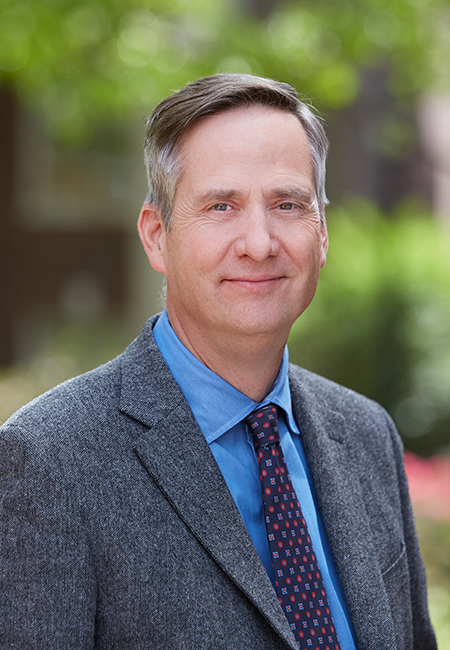
A critical step toward a bright future in higher education is to address the loss of academic readiness among K–12 students. Dean Grossman has argued in Education Week for innovations that would give students more time to master the past year’s content. With federal funding, she proposes, states could create extended school days and summer academies, hire unemployed people to become trained tutors, and establish cross-grade classrooms to accommodate different levels of learning.
With a new administration in Washington, Perna sees an opportunity for policy to be advanced to address college affordability. “I’m excited about the potential for a federal–state partnership, which could mean some kind of free community college program,” she says. Such a step would build on the precedent of state and local College Promise programs that help students afford postsecondary education, often at a community college, a trend Perna has documented with the help of Elaine Leigh, GED’10, a student in Penn GSE’s Higher Education Ph.D. program.
“I hope our work on College Promise programs can help institutions and communities think through how they want to support students as they look for ways to rebuild and recover in the years to come,” says Leigh.
At the state level, governmental action is essential to drive economic recovery and educational opportunity, according to a policy brief released by recently retired Penn GSE Professor of Practice Joni Finney and colleagues. With governor-appointed statewide task forces, they argue, states can develop sustainable funding strategies and invest in the institutions best positioned to prepare the workforce, including public community colleges and regional four-year universities.
“Leadership in this time of crisis requires bold action that acknowledges historical barriers and prioritizes supports for the recently unemployed, students of color, low-income individuals, adults, and those populations impacted by COVID-19,” write Dr. Finney and coauthors in the brief.
González Canché sees a role for community colleges in preparing workers for a green energy future. “There will be a need for retraining and continuous education, and community colleges can be a fundamental player,” he says.
Community colleges are also poised to prepare students for other industries key to recovery, including transportation, logistics, distribution, information technology, engineering, finance, health care, and hospitality, according to Michael A. Cioce, GRD’18. A graduate of Penn GSE’s Executive Doctorate in Higher Education Management program, Dr. Cioce is president of Rowan College at Burlington County, one of two New Jersey community colleges partnered with the public Rowan University to create accessible pathways to a bachelor’s degree.
“The students who trusted in us during the pandemic have not been let down on the quality side,” Cioce says. “We pride ourselves on providing a high-quality academic experience at a low cost, and I think we’ve found some big fans over the past year.”
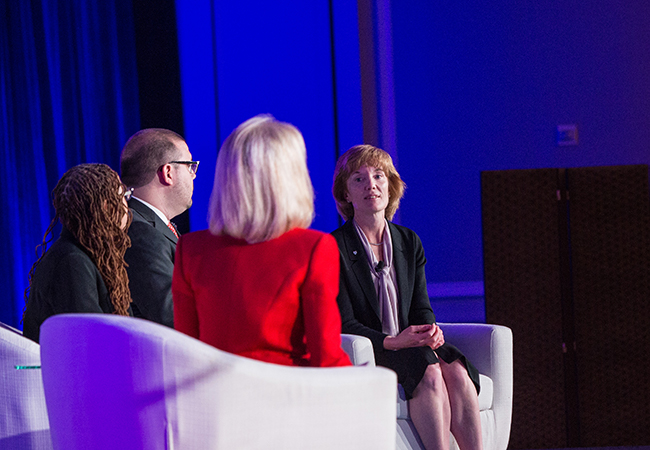
In addition to a prominent role for community colleges, Penn GSE faculty, students, and alumni foresee new approaches to teaching, technology, global engagement, and diversifying the workforce.
A national dialogue about teaching, prompted by the shift to virtual education, has been a positive effect of the pandemic— one that promises to propel innovation even when in-person instruction resumes, according to many Penn GSE faculty. “We’ve seen a conversation about how to deepen and broaden learning on an unprecedented scale,” says Eckel.
To examine technology’s potential in higher education, Perna is working with Penn GSE Higher Education graduate Roman Ruiz, GR’20, a researcher at American Institutes for Research in Arlington, Virginia. “My hope is that technology can be used to equalize educational opportunity and not as another mechanism to limit access or divert students from postsecondary pathways that would benefit them the most,” Dr. Ruiz says.
Technological access for students may be addressed through new partnerships between universities and private companies. “There’s an increased willingness of universities to partner with outside organizations to create solutions,” Catalyst’s Michael Golden says.
Technology could reduce obstacles to global engagement, according to Sijie (Bess) Li, a Penn GSE master’s student in the International Educational Development Program. Li has undertaken the internship for her program virtually, working for UNESCO Paris Higher Education Sector. “The core of international education is the exchange of different opinions and viewpoints across national and cultural borders,” she says. “Virtual mobility could complement physical mobility and expand access.”
Nationally, dialogues about systemic racism have increased at- tention to the role of Historically Black Colleges and Universities (HBCUs) in creating opportunity for Black students. Ivy Taylor, GRD’20, a graduate of Penn GSE’s Executive Doctorate in Higher Education Management program, aims to capitalize on this strength to change the racial demographics of key fields as president of Rust College, an HBCU in Holly Springs, Mississippi.
“I realized that HBCUs were a way that I could really live out my mantra of connecting people to opportunity, because these are institutions that have been doing that for many decades,” says Dr. Taylor. Formerly mayor of San Antonio, Texas, she came to Penn GSE with the goal of leading an HBCU and interviewed for the presidency of Rust during the pandemic while still enrolled at Penn GSE. Now, Taylor is placing a focus on the college’s communica- tions and education departments as she draws inspiration from journalist and activist Ida B. Wells-Barnett, who attended Rust in the late nineteenth century to prepare for her early teaching career.
“I get so excited about creating the pipeline of the next generation of Black journalists and storytellers who can help shape public policy dialogue,” she says. “We also need to bring more Black and Brown people into the classroom as teachers. Statistics show that students have better outcomes when they see teachers who look like them for at least some portion of their educational experience.”
For Penn GSE, perhaps the greatest source of hope for the future of higher education is the School’s community of alumni and students determined to make a difference.
“There are many ways in which higher education has the opportunity to do and be better, but I strongly believe in the public value of postsecondary education,” says Elizabeth Dunens, a student in Penn GSE’s Higher Education Ph.D. program. “I am excited and grateful to get to be a part of realizing its future in the decades to come, and in the meantime to consider critically and creatively the possibilities for this future as a Penn GSE student.”
This article appeared in the Spring 2021 issue of The Penn GSE Magazine.

